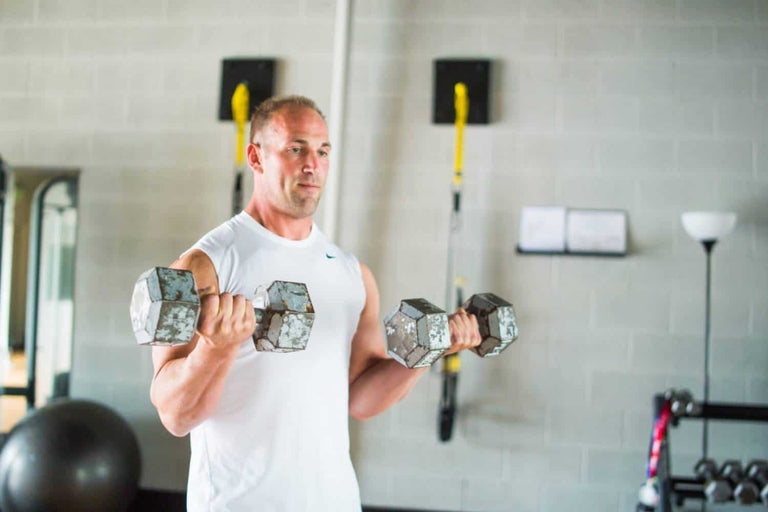There’s no doubt that increasing muscle increases absolute strength—but as important as absolute strength is in many sports, relative strength is often more important. While I would argue (and have) that gaining muscle (and therefore weight) is still a better way to increase your relative strength than losing fat, it can be a difficult pill to swallow. Why not gain muscle and lose fat, some argue, and thus keep your weight static?
The idea of gaining muscle and losing fat in more-or-less equal amounts is formally known as body recomposition. By itself, body recomposition doesn’t imply that the two must occur simultaneously, but to many people this is its holy grail—with simultaneous muscle gain and fat loss, you get maximum results in minimum time.
Unfortunately, holy grails rarely turn out to be more than myths; such is the case with 1 for 1 body recomposition. Over time, you can easily replace fat with muscle by interchanging strengthening phases with leaning phases—but trying to do both at the same time is a recipe for disappointment.
1 to 1 Body Recomposition: The Hypothesis
Our body stores a tremendous amount of energy in the fat. Even an extremely lean male with only 5% body fat has over 20,000 calories locked away in their minimal adipose tissue; most people have enough fat to run non-stop from Denver to Los Angeles. Surely there’s enough energy available from the fat to power muscle growth, right?
This is the basic hypothesis behind 1 to 1 body recomposition: our body has adequate fat energy to power muscle gain without external energy being necessary. This hypothesis is simplistic, though, because it assumes that the only control on muscle growth is available energy. The truth is more complicated.
Gaining muscle (or fat) is an anabolic process while losing fat (or muscle) is a catabolic process. Anabolic processes build up molecules or structures and consume energy; catabolic processes break down molecules or structures and release energy. The sum total of our anabolic and catabolic processes is termed our metabolism.
Whenever we eat excess calories, our metabolism shifts more towards the anabolic side of the equation because there is excess energy, and in order to return to equilibrium that energy must be used either by building something or storing it. If you’re training hard and consuming more than the calories you require for maintenance, then your body will use those calories to build muscle.
On the other hand, whenever we consume an inadequate amount of calories, our metabolism shifts more towards the catabolic side; with a dearth of energy, it needs to recoup the lack in order to maintain normal function. In addition, when calories are inadequate our body begins to sequester them, naturally putting a damper on less essential anabolic processes like muscle protein synthesis.
If you think of calories as a currency, this makes sense. When you are flush with cash, you can be less discriminating about what you spend it on because you have an excess to what you need to survive. When your funds dry up, though, you need to budget in order to spend them most wisely on what is absolutely essential. Muscle growth and sports cars are not essential—and if you already have them, the at best you may be able to hold onto them.
So the first big issue with the 1 to 1 body recomposition hypothesis is that the total number of calories you consume (or have available in the blood)—not the total you have stored in your body—is what determines the balance between your anabolism and catabolism. When you’re in a catabolic state (a caloric deficit), it just doesn’t make biological sense for your body to use fat calories to build muscle, just like it wouldn’t make sense to use your savings to buy a sports car when you lose your job.
You Can Gain Muscle While Losing Weight, Though!
Of course, our metabolism is more complicated still than just being about calories in and calories out. Sometimes gaining muscle is considered to be essential. For example, it’s well known that new lifters gain muscle faster and often regardless of their nutrition. This is precisely because their body is undergoing such a strong, novel synthesis that it’s difficult for the body to consider it unimportant, and thus it devotes resources (even when scarce) to its development. To the body, it seems like gaining muscle is necessary to avoid future danger.
Furthermore, obese individuals very frequently gain significant amounts of muscle during weight loss when it’s paired with an exercise routine. One consequence of obesity, particularly central obesity, is that the body releases an excess amount of free fatty acids, even outside of exercise. This can cause a variety of metabolic problems, such as insulin resistance and high cholesterol, but also effectively increases the “free pool” of energy—it’s no longer locked away in the fat, so even in a caloric deficit there is plenty of readily available energy to devote towards muscle growth, and thus obese individuals can sidestep the issue.
In athletes who are not new to training, however, muscle gain will never match fat loss. Often, it’s all an athlete can do to prevent lean muscle loss. Even in the examples where lean muscle is gained, though, it’s minimal and far out-stripped by fat loss.
There’s no doubt that minimizing muscle loss (or even gaining slight amounts of muscle) is preferable to the alternative during weight loss. But there’s also no doubt that if muscle gain is your goal, you’re better off focusing solely on that strategy—and that means forgetting, at least temporarily, about losing fat.
Break Body Recomposition into Its Parts
The good news is that over the long term, 1 to 1 body recomposition is possible—you just shouldn’t combine the fat loss and strength gain into the same phase. A better way is to focus on each separately with a stretch goal of increasing strength and losing fat.
When you focus on gaining strength, you’re making a conscious choice to consume enough calories to support the anabolic side of your metabolism; you’re providing enough calories to build muscle, and must accept that some of those calories may be used to build fat as well. If you work with a sports nutritionist, or do the calculations yourself, you can minimize fat gain (or even avoid it entirely) while not harming muscle growth.
When you focus on losing fat, you’re making a conscious choice not to consume enough calories to encourage muscle growth in order to support the catabolic side of your metabolism and lose fat; your body will recoup the missing calories from your fat, but also downregulate anabolic processes like muscle growth. If you’re careful, you can prevent most or all muscle loss, and may even be able to gain slight amounts of muscle.
When these phases are combined over months and years, the result is an improved physique. And clearly, this is exactly what happens. Look at the progress any serious athlete makes over a year, or over five years—that is body recomposition. It doesn’t happen instantly; it takes time.
There’s an old adage not to take shortcuts; you shouldn’t try to take shortcuts with your body composition, either. Take the time to do it right. Be content with gaining muscle and losing fat separately. Think long-term, not short. With patience, you will achieve far more!



